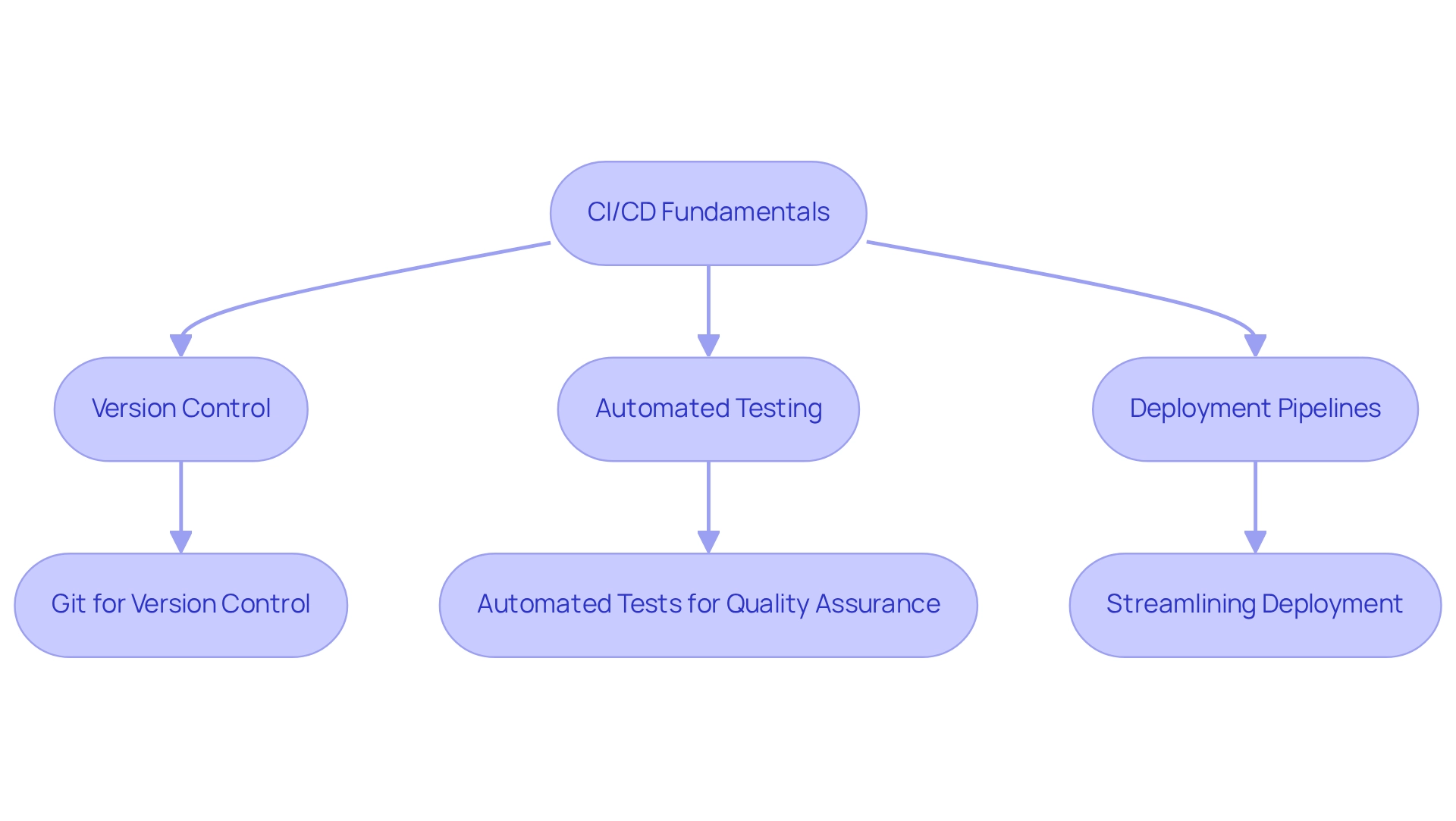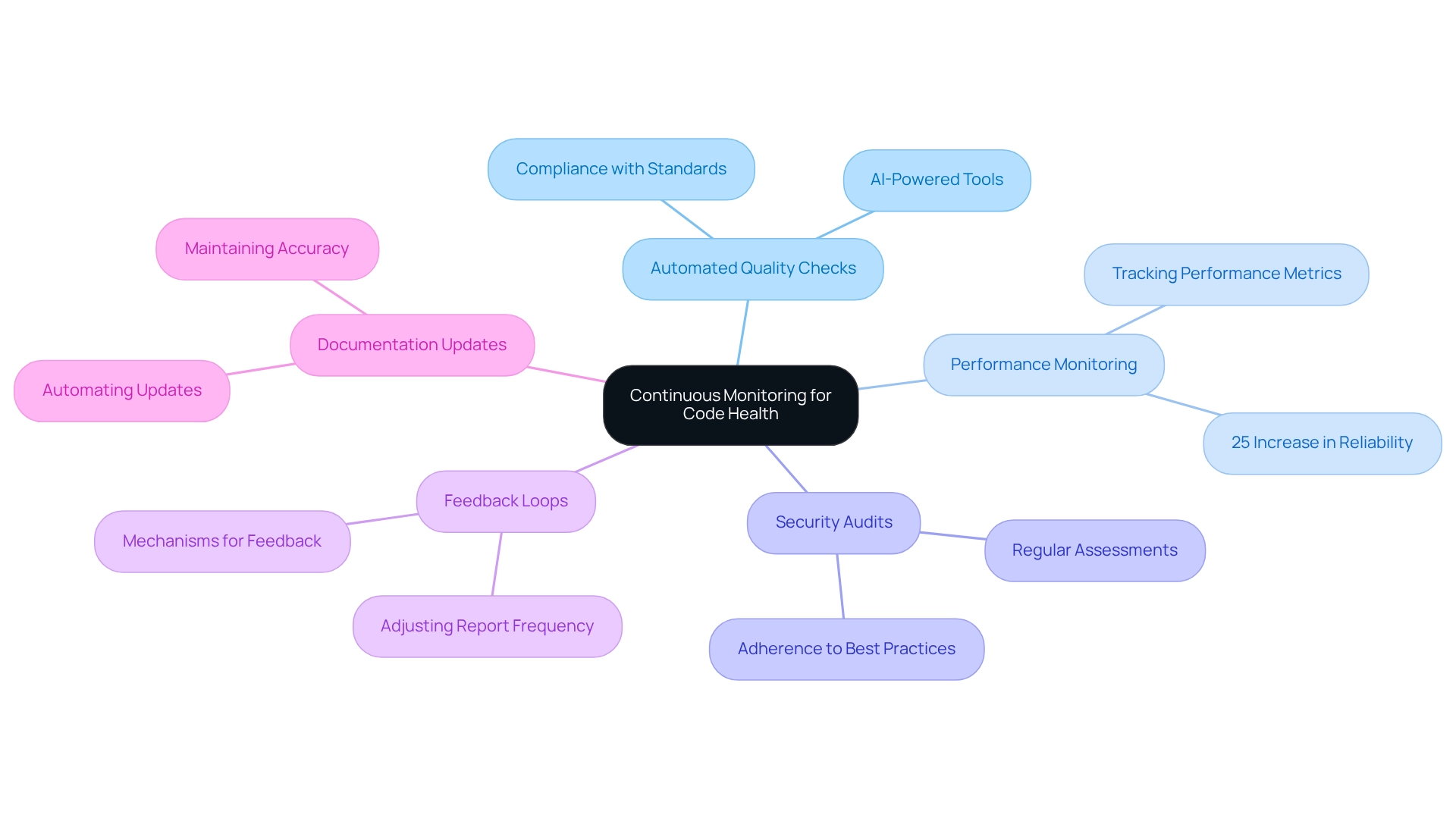Overview
The article addresses the challenges developers face in coding, particularly in the realm of Continuous Integration and Continuous Deployment (CI/CD). It highlights three essential strategies for effective CI/CD code optimization:
- Committing code frequently
- Automating testing
- Implementing continuous monitoring
These strategies are crucial for improving software development efficiency and quality. By streamlining workflows and enhancing code health, organizations adopting these practices have demonstrated increased reliability and reduced deployment issues. The evidence supports the notion that these strategies significantly contribute to a more effective development process.
Introduction
In the fast-evolving landscape of software development, developers often grapple with numerous coding challenges that can hinder their progress. How can these issues be effectively addressed? The integration of Continuous Integration (CI) and Continuous Delivery (CD) has emerged as a cornerstone for success. Tools like Kodezi rise to the occasion, offering automation for code improvements, bug detection, and performance optimization before deployment. This significantly reduces the risk of errors and enhances overall code quality.
As organizations increasingly adopt CI/CD practices, understanding the fundamentals and best practices becomes essential for fostering a resilient and efficient development environment. Kodezi not only streamlines the development process but also allows teams to respond swiftly to changing demands. By leveraging Kodezi, developers can improve their productivity and ensure their code meets high standards.
This article delves into the key strategies and innovations that can transform CI/CD workflows. Are you ready to explore how Kodezi can help you remain competitive in a dynamic industry? Discover the tools available on the platform and see how they can enhance your coding practices.
Understand CI/CD Fundamentals for Effective Code Optimization
In today's fast-paced software development landscape, coding challenges are ever-present. Continuous Integration (CI) and Continuous Delivery (CD) are vital solutions that rely on ci/cd code optimization to automate the integration and deployment of changes, enhancing efficiency and ensuring high quality. CI involves the regular merging of changes into a shared repository, where automated builds and tests help identify issues early in the development cycle. Here, Kodezi CLI plays a crucial role by autonomously enhancing software quality, fixing bugs, optimizing performance, and ensuring security compliance before the program reaches production. This proactive approach significantly reduces the risk of errors during deployment.
But what are the key concepts that make CI and CD effective? Consider the following:
- Version Control: Utilizing systems like Git allows for efficient management of changes, ensuring that all modifications are tracked and easily reversible.
- Automated Testing: By implementing automated tests during the CI process, teams can validate software quality, which is essential for catching bugs before they reach production. Kodezi's automated debugging features enable quick problem resolution, further enhancing the testing phase.
- Deployment Pipelines: These pipelines streamline the transition of software from development to production, minimizing downtime and thereby boosting overall efficiency.
As we look ahead to 2025, the adoption of CI and CD continues to rise, with many organizations integrating these methodologies into their workflows. This shift is driven by the demand for faster deployment cycles and improved code quality. Research indicates that teams employing CI and CD experience a notable increase in deployment speed and a decrease in production issues.
Real-world examples illustrate the effectiveness of CI and CD in enhancing code quality. Organizations that embrace these practices report fewer deployment failures and faster recovery times, underscoring their importance in maintaining a robust codebase. Industry leaders emphasize that adopting CI and CD is not merely a trend; it is essential for staying competitive in an evolving software landscape. Kodezi distinguishes itself by offering comprehensive automated debugging and optimization capabilities that enhance ci/cd code optimization in the process. By mastering these fundamental concepts and leveraging tools like Kodezi, teams can uncover optimization opportunities within their ci/cd code optimization workflows. Ultimately, this leads to a more resilient and efficient development process. Are you ready to explore the tools available on the Kodezi platform and elevate your coding practices?

Implement Best Practices to Streamline CI/CD Processes
To streamline processes, developers often face significant challenges in ci/cd code optimization. How can these hurdles be effectively addressed? By implementing best practices, teams can enhance their workflows and improve productivity through ci/cd code optimization.
- Commit Early and Often: Encouraging developers to commit code changes frequently minimizes merge conflicts and simplifies integration. This fosters a smoother workflow. Statistics indicate that more than half of surveyed teams utilize DevOps practices to deploy containers, highlighting the growing importance of these methodologies in modern software development.
- Automate Testing: Implementing automated tests at every stage of the pipeline aids in identifying problems early. This ensures high quality and lowers the risk of defects in production.
- Optimize Build Times: Utilizing caching and parallel builds significantly reduces the time required for compiling and testing programs. This not only accelerates feedback loops but also enhances overall productivity.
- Maintain a Single Source Repository: Centralizing all changes in a single repository simplifies version control and collaboration. This makes it easier for teams to manage their codebase effectively.
- Implement Continuous Feedback: Leveraging advanced monitoring tools, such as full pipeline tracking and system health checks, provides real-time feedback on code quality and deployment success. This allows teams to proactively tackle problems, ensuring a more robust development and deployment pipeline.
By embracing these methods, teams can establish a more effective continuous integration and delivery workflow that facilitates swift development cycles while upholding high quality standards. As noted by Cody Slingerland, 'Drift is saving $2.4 million annually on AWS costs,' illustrating the financial benefits of ci/cd code optimization processes. Furthermore, monitoring metrics enables organizations to establish benchmarks for enhancement and assess the influence of modifications over time, promoting a culture of ongoing learning and development within teams.

Leverage Continuous Monitoring for Long-Term Code Health
In the ever-evolving landscape of software development, teams face numerous coding challenges that can hinder long-term software health. To combat these issues, adopting continuous monitoring practices is essential. This approach encompasses several key strategies that can significantly enhance productivity and code quality.
- Automated Quality Checks: How can developers ensure their code meets industry standards? Implementing tools like Kodezi can provide the answer. Kodezi's AI-powered features automatically analyze software for compliance with coding standards and best practices, highlighting potential issues for developers to address promptly. This not only improves overall software quality but also fosters a proactive development environment.
- Performance Monitoring: Are you aware of how performance bottlenecks can impact your application? By continuously tracking application performance metrics, teams can swiftly identify slowdowns and resolve them in real-time. Kodezi assists in this process by enhancing formatting in mere seconds, significantly boosting application reliability. In fact, companies utilizing AI-powered monitoring systems have reported a remarkable 25% increase in overall application reliability.
- Security Audits: What measures are in place to protect your software from vulnerabilities? Conducting regular security assessments is crucial for uncovering weaknesses and ensuring adherence to industry standards. Kodezi guarantees that your programming repository aligns with the latest security best practices, safeguarding it while promoting trust among users and stakeholders.
- Feedback Loops: How does your team handle feedback on code modifications? Establishing robust mechanisms for developers to receive feedback fosters a culture of ongoing enhancement. By adjusting report generation frequency based on project phases, teams can further improve these feedback loops.
- Documentation Updates: Are your documentation practices keeping pace with code changes? Automating documentation updates alongside code modifications is vital for maintaining accuracy and relevance. This ensures that all team members have access to the latest information, thereby shortening onboarding duration for new engineers and reducing technical debt.
According to a recent survey by Forrester, companies leveraging AI for troubleshooting report a staggering 40% reduction in resolution times. By embracing continuous monitoring and utilizing tools like Kodezi, teams can achieve ci/cd code optimization to maintain a high-quality codebase that evolves with their needs. This ultimately leads to enhanced performance and reduced technical debt. Explore the tools available on the Kodezi platform today to elevate your coding practices.

Conclusion
Mastering Continuous Integration (CI) and Continuous Delivery (CD) is essential for developers facing the challenges of enhancing code quality and streamlining workflows. By grasping the fundamentals—such as version control, automated testing, and deployment pipelines—teams can significantly reduce errors and improve productivity. Tools like Kodezi address these challenges by offering automation for code improvements, bug detection, and performance optimization. This makes the development cycle more efficient and effective.
Implementing best practices, such as committing code frequently, automating testing, and maintaining a single source repository, can further optimize CI/CD processes. These strategies not only foster collaboration but also enable teams to deliver high-quality code at a faster pace. Real-world examples show that organizations adopting these practices experience fewer deployment failures and quicker recovery times. This reinforces the necessity of CI/CD in today’s competitive software landscape.
Furthermore, continuous monitoring is crucial for maintaining long-term code health. By leveraging tools that automate code quality checks, monitor performance, and conduct security audits, teams can ensure their codebase remains robust and secure. Emphasizing feedback loops and automated documentation updates enhances adaptability and reduces technical debt. This provides a comprehensive approach to software development. Ultimately, embracing CI/CD and utilizing tools like Kodezi positions organizations for sustained success in an ever-evolving industry.
Frequently Asked Questions
What are Continuous Integration (CI) and Continuous Delivery (CD)?
CI and CD are vital solutions in software development that automate the integration and deployment of changes, enhancing efficiency and ensuring high quality. CI involves regularly merging changes into a shared repository, while CD focuses on the automated delivery of those changes to production.
How does Kodezi CLI contribute to CI and CD?
Kodezi CLI plays a crucial role by autonomously enhancing software quality, fixing bugs, optimizing performance, and ensuring security compliance before the program reaches production, significantly reducing the risk of errors during deployment.
What is the importance of version control in CI/CD?
Version control systems like Git allow for efficient management of changes, ensuring that all modifications are tracked and easily reversible, which is essential for maintaining a reliable codebase.
Why is automated testing important in the CI process?
Automated testing during the CI process is crucial for validating software quality and catching bugs before they reach production. Kodezi's automated debugging features facilitate quick problem resolution, enhancing the testing phase.
What are deployment pipelines and their benefits?
Deployment pipelines streamline the transition of software from development to production, minimizing downtime and boosting overall efficiency.
What trends are expected for CI and CD adoption by 2025?
The adoption of CI and CD is expected to rise, driven by the demand for faster deployment cycles and improved code quality. Teams using CI and CD typically experience increased deployment speed and fewer production issues.
How do CI and CD practices impact code quality in organizations?
Organizations that embrace CI and CD report fewer deployment failures and faster recovery times, highlighting their importance in maintaining a robust codebase and staying competitive in the software landscape.
What advantages does Kodezi offer in the context of CI/CD?
Kodezi distinguishes itself by providing comprehensive automated debugging and optimization capabilities that enhance CI/CD code optimization, helping teams uncover optimization opportunities within their workflows.




